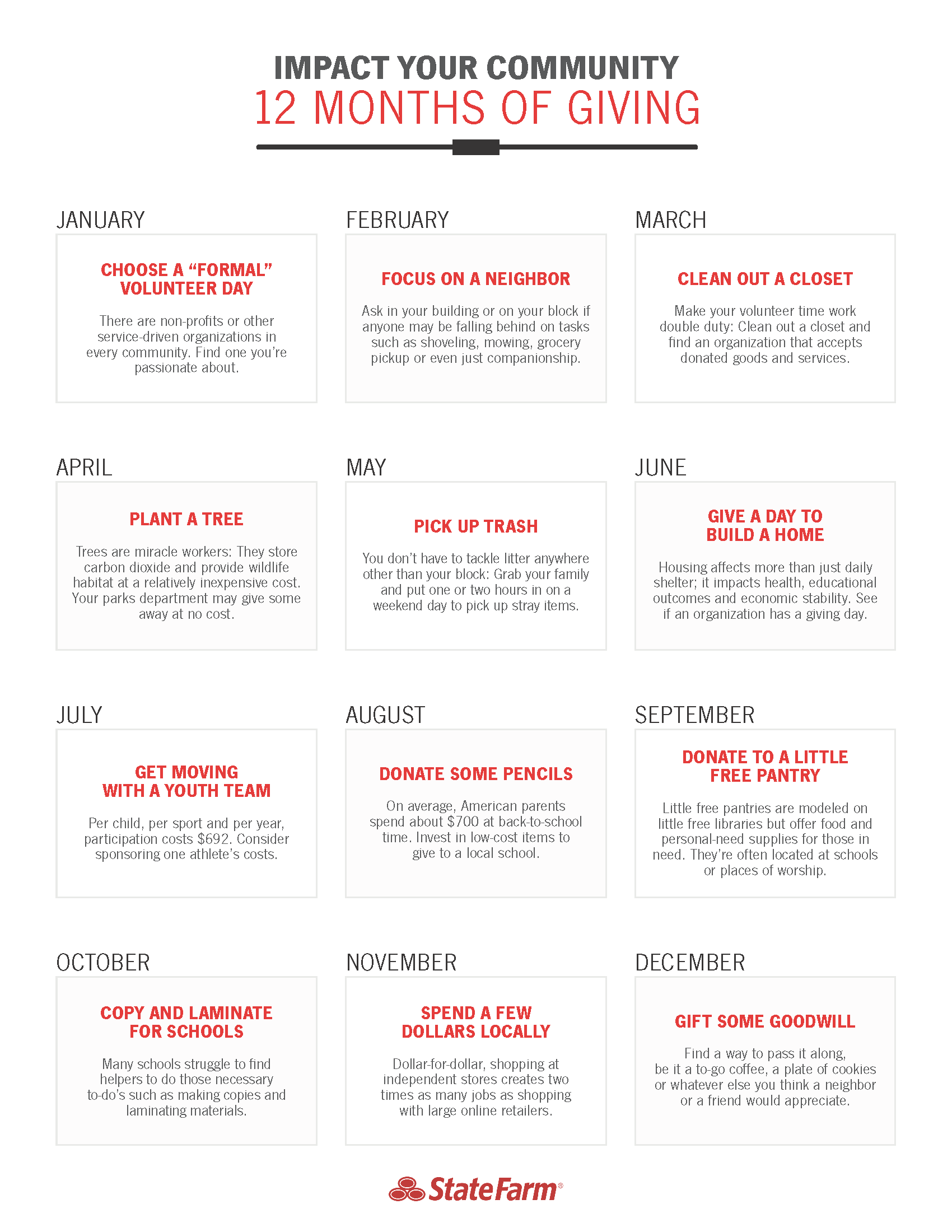Volunteer ideas: 12 months of giving
Volunteering is very much on the minds — and on the calendars — of Americans. More than 30% of Americans, or 77.3 million people, volunteered with an organization in 2018. However, that doesn't include informal volunteering — those small acts of kindness for friends, family and strangers or even just favors for neighbors.
If you expand your view of giving, you'll come up with even more ways to make your community better this year — one neighbor or organization at a time. Use this list of monthly volunteer ideas to stitch together 12 months of giving. The result is 12 months of community impact that can change the world around you. (Download the printable 12 Months of Giving ideas to keep this front and center at home.)
January: Choose one "formal" volunteer day
There are nonprofits or other service-driven organizations in every community. They include everything from food pantries to hospitals and animal shelters. While many see a flood of volunteers during the year-end holiday season, they're often short-staffed during the rest of the year. Call ahead to see how you can fit in a shift that works with your schedule this month.
February: Focus on a neighbor
Ask in your building or on your block if anyone may be falling behind on tasks such as shoveling, mowing, grocery pickup or even just companionship. For example, about 30 percent of older adults live alone, and that may affect their overall health. To break the ice with someone you don't know, stop by with a cup of coffee or a treat.
March: Clean out a closet
One way to make your donation work harder is to investigate organizations that accept donated goods and services. Only about 20 percent of donated clothing is actually resold domestically; the rest is either shipped overseas to be resold, recycled or brought to a landfill. You may want to consider a local organization that offers a free "closet"for people in need. Or, find a group that donates professional clothes to nonprofits that outfit people for job interviews.
April: Plant a tree
Trees are miracle workers. They store carbon dioxide and provide wildlife a habitat. Scientists also estimate a worldwide tree planting initiative could remove two-thirds of existing carbon emissions. Check with your municipality about tree planting or giveaway programs. If your yard doesn't need one, contact your parks department to see if they can use a new tree.
May: Pick up some trash
You don't have to tackle litter anywhere other than your block: Grab your family and put one or two hours in on a weekend day to pick up any stray items.
June: Give a day to build a home
Housing affects more than just daily shelter; it impacts health, educational outcomes and economic stability. Organizations such as Habitat for Humanity often have build days or operate resale stores that are in need of volunteers.
July: Get moving — with a youth team
Per child, per sport and per year, participation costs an average of $692. Transportation and supplies are two of the contributing factors — and may be why children from low-income families play sports half as much as those from high-income families. By dedicating a few hours a week, you can teach a dozen or more kids the importance of hard work, teamwork and exercise. Contact a local school to see if you can volunteer to help with rides, snacks or even coaching.
August: Snag some pencils to give away
American public school teachers can spend up to $2,000, out of pocket, on classroom supplies. Know a teacher? Ask what students in their classroom need throughout the year and drop off a bag of that item for general use.
September: Donate to a little free pantry
You've probably seen a little free library or two in your community — front-yard, birdhouse-size book repositories in which neighbors can leave books for the taking. Little free pantries are modeled on that idea but designed to offer food and personal-need supplies for those in short supply. They're often located at schools or places of worship; click to find a map of nearby locations.
October: Copy and laminate for schools
While classrooms and teachers generally welcome volunteers, many schools struggle to find helpers to do those necessary to-dos such as making copies and laminating materials. Ask a local school's front desk if there's a resource for helping out in this much-needed area.
November: Support local businesses
Dollar-for-dollar, shopping at independent stores creates two times as many jobs as shopping with large online retailers. During the holiday season, pick a new-to-you store to support.
December: Gift some zen
Remember informal giving — the idea of just doing something for a neighbor or a friend? During the busy holiday season find a way to pass along goodwill, be it a to-go coffee, a plate of cookies or whatever else you think a neighbor or a friend would appreciate.





